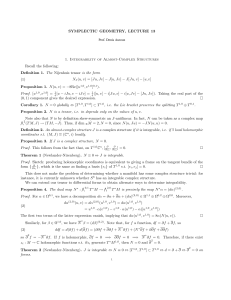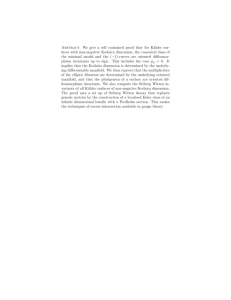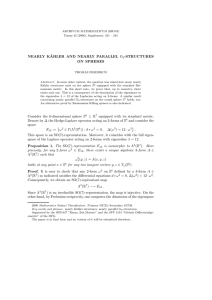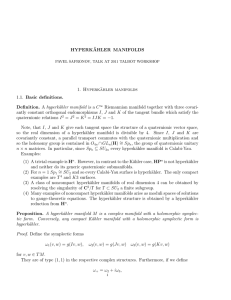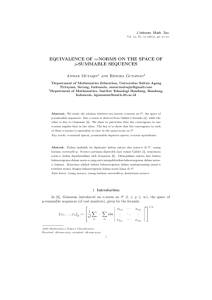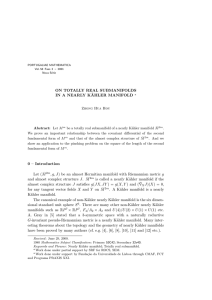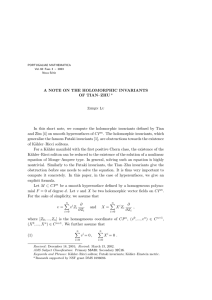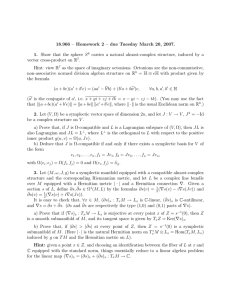SYMPLECTIC GEOMETRY, LECTURE 14 1. K¨
advertisement
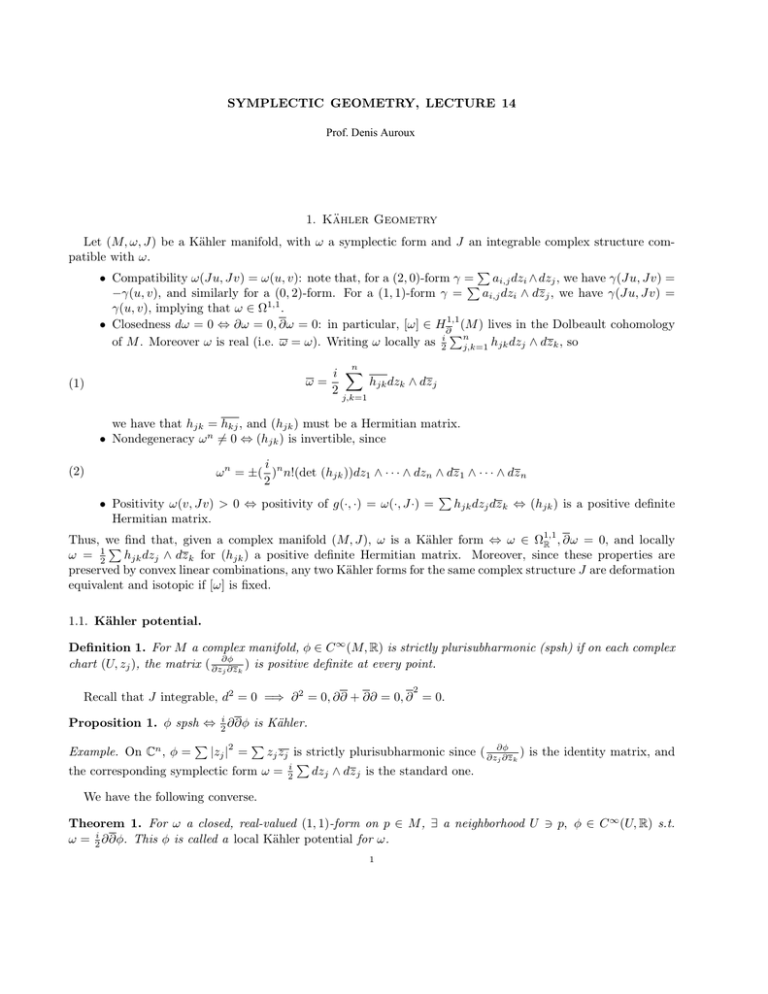
SYMPLECTIC GEOMETRY, LECTURE 14
Prof. Denis Auroux
1. Kähler Geometry
Let (M, ω, J) be a Kähler manifold, with ω a symplectic form and J an integrable complex structure com­
patible with ω.
�
• Compatibility ω(Ju, Jv) = ω(u, v): note that, for a (2, 0)-form γ =
� ai,j dzi ∧ dzj , we have γ(Ju, Jv) =
−γ(u, v), and similarly for a (0, 2)-form. For a (1, 1)-form γ =
ai,j dzi ∧ dz j , we have γ(Ju, Jv) =
γ(u, v), implying that ω ∈ Ω1,1 .
• Closedness dω = 0 ⇔ ∂ω = 0, ∂ω = 0: in particular, [ω] ∈ H∂1,1 (M ) lives in the Dolbeault cohomology
�n
of M . Moreover ω is real (i.e. ω = ω). Writing ω locally as 2i j,k=1 hjk dzj ∧ dz k , so
ω=
(1)
n
i �
hjk dzk ∧ dz j
2
j,k=1
we have that hjk = hkj , and (hjk ) must be a Hermitian matrix.
• Nondegeneracy ω n �= 0 ⇔ (hjk ) is invertible, since
(2)
i
ω n = ±( )n n!(det (hjk ))dz1 ∧ · · · ∧ dzn ∧ dz 1 ∧ · · · ∧ dz n
2
�
• Positivity ω(v, Jv) > 0 ⇔ positivity of g(·, ·) = ω(·, J ·) =
hjk dzj dz k ⇔ (hjk ) is a positive definite
Hermitian matrix.
1,1
Thus, we
�find that, given a complex manifold (M, J), ω is a Kähler form ⇔ ω ∈ ΩR , ∂ω = 0, and locally
1
ω = 2
hjk dzj ∧ dz k for (hjk ) a positive definite Hermitian matrix. Moreover, since these properties are
preserved by convex linear combinations, any two Kähler forms for the same complex structure J are deformation
equivalent and isotopic if [ω] is fixed.
1.1. Kähler potential.
Definition 1. For M a complex manifold, φ ∈ C ∞ (M, R) is strictly plurisubharmonic (spsh) if on each complex
chart (U, zj ), the matrix ( ∂z∂φ
) is positive definite at every point.
j ∂z k
2
Recall that J integrable, d2 = 0 =⇒ ∂ 2 = 0, ∂∂ + ∂∂ = 0, ∂ = 0.
Proposition 1. φ spsh ⇔ 2i ∂∂φ is Kähler.
�
�
2
|zj | =
Example. On Cn , φ =
zj zj is strictly plurisubharmonic since ( ∂z∂φ
) is the identity matrix, and
j ∂z k
�
i
the corresponding symplectic form ω = 2
dzj ∧ dz j is the standard one.
We have the following converse.
Theorem 1. For ω a closed, real-valued (1, 1)-form on p ∈ M , ∃ a neighborhood U � p, φ ∈ C ∞ (U, R) s.t.
ω = 2i ∂∂φ. This φ is called a local Kähler potential for ω.
1
Prof. Denis Auroux
2
1.2. Examples of Kähler Manifolds.
Example. Any complex submanifold of (Cn , ω) is Kähler, with the inherited complex and symplectic structures.
Example. Complex projective space CPn = Cn+1 � {0}/C∗ is Kähler: letting
(3)
Ui = {(z0 : · · · : zi−1 : 1 : zi+1 : · · · : zn )}
be the standard charts ∼
= Cn , we have the Fubini-Study K¨ahler form
i
2
(4)
ωF S = ∂∂ log(1 + |z| )
2
(since f (z) = log(1 + |z |)2 is spsh). Explicitly,
�
�
�
2 �
zj dz j
(1 + |z| ) dzj ∧ dz j − ( z j dzj ) ∧ ( zj dz j )
(5)
∂∂f = ∂
2 =
2
1 + |z|
(1 + |z| )2
Applying this to v ∈ T 1,0 , v ∈ T 0,1 , we obtain
2
(6)
2
2
(1 + |z| ) |v| − |�z, v�|
2
(1 + |z| )2
2
≥
|v|
2
(1 + |z| )2
Since 2i ∂∂f (u, iu) = ∂∂f (u1,0 , u1,0 ), we have the desired positivity. Moreover, for φ a transition map (WLOG
2
2
between U0 and U1 ), we have that φ∗ f = log(1 + |z| ) − log |z1 | =⇒ ∂∂(φ∗ f ) = ∂∂f since
z1 dz 1
d z1
2
∂∂ log |z1 | = ∂
=0
(7)
2 =∂ z
1
|z1 |
Finally, recall that H 2 (CPn , R) = R, and H2 (CPn ) is generated by [CP1 ]. The class of [ω] is thus defined by the
value of
�
1
[ω] · [CP ] =
ωF S = Area(CP1 , ωF S )
(8)
CP1
Example. Any complex submanifold of CPn (i.e. complex projective variety) is Kähler.
Theorem 2 (Kodaira Embedding). Let (X, ω, J) be a compact Kähler manifold, with [ω] ∈ H 2 (X, R) an integral
class. Then ∃ a holomorphic embedding X �→ CPn making it a complex projective variety, with ω differing from
ωF S by a scaling factor.
Theorem 3 (Hodge). For (M, ω) a compact Kähler manifold, the Dolbeault cohomology groups H∂p,q (M ) satisfy
�
H k (M, C) = p+q=k H∂p,q (M ) and H p,q ∼
= H q,p .
Corollary 1. dim H k (M ) is even for odd k.
Example. In the 70’s, Kodaira and Thurston independently studied a closed 4-manifold which carries both a
complex structure and a symplectic structure but which is not Kähler.
